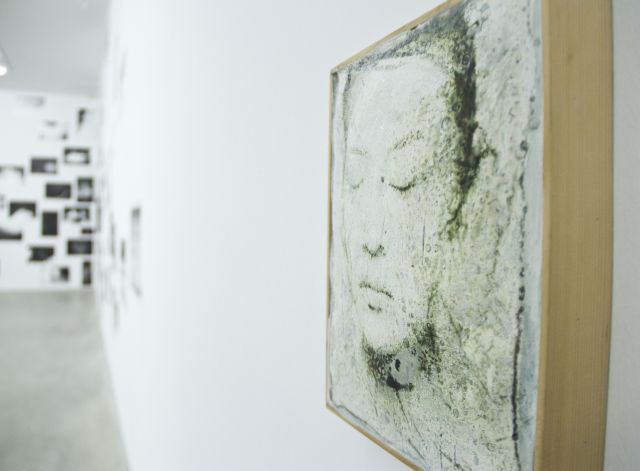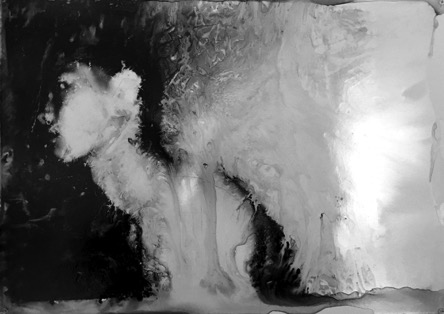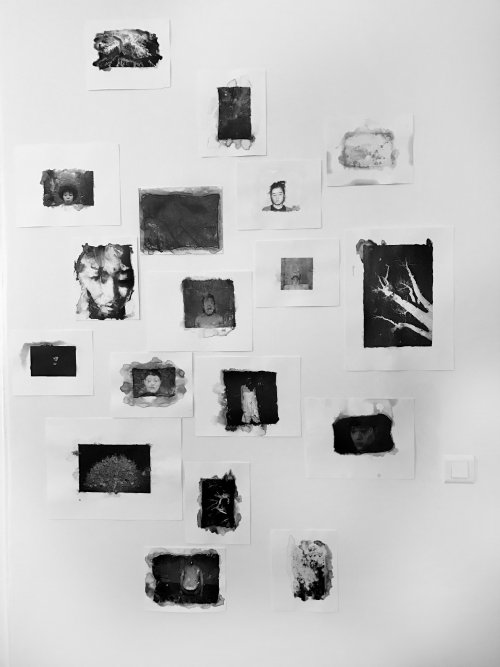
Accueil > Les rubriques > Images > Liminal Space
Liminal Space
Fan Xi and the de-iconification of the world of images
, et
Toutes les versions de cet article : [English] [中文]
Roland Barthes drew a critical conclusion on contemporary photography in Camera Lucida : Reflections on Photography : the contemporary transformed the world into images, where photographs allowed the world to come to the surface, where people’s desires are magnified. As a technique of image production, photography is divided into two paths : one is studium, and the other is punctum [2].

- Portrait on Paper No.84
- 胶片、综合材料 film, mixed material
I
Since the beginning, the photograph’s testimonial property is similar to Gerhard Richter’s “photo-realism” that attempts to wipe out “the subjective and spiritual residue of every detail” through meticulous depiction of existing objects, by which to maintain a neutral and anonymous attitude. While this viewpoint is not new, insofar as the invention of photography at the beginning of the Nineteenth century, the debate evolved around painting and photography has not ceased, primarily evolved around whether photography produces images devoid of metaphorical meaning ? For Roland Barthes, photographs are “that-has-been”, it’s a testimony, a “curse”, not art, because everything is given without provoking the desire for or even the possibility of a rhetorical expansion [3]. While Blanchot held the opposite view, who stated, “The essence of the image is to be altogether outside, without intimacy, and yet more inaccessible and mysterious than the thought of the inner most being ; without signification, yet summoning up the depth of any possible meaning ; unrevealed yet manifest, having that absence-as-presence which constitutes the lure and the fascination of the Sirens.” [4]
This debate anchors the dialectical qualities in the medium of photography : on the one hand, the realistic and testimonial qualities allow photography shoots reality into images, lucidly exposing everything in front of the viewer ; on the other hand, the image frames and magnifies the features of everyday reality forcing them to confront the reality in the photograph. Those experience and phenomenon we are indifferent of suddenly draws our attention, and become the object framed and reiterated by various art theories, as if there is still certain source of undisclosed meaning in very moment framed by the lens – a viewing experience would urge people to realize their distant separation from the so-called “reality” through the lens. Roland Barthes satirically banters, the image world backfires all people’s everyday experiences, exacerbates people’s sense of distance in treating their daily experiences, so they would sometimes agree that, “Look, how gloomy they are ! Nowadays the images are livelier than the people.” [5]
Images reconstruct the real experiences of our everyday life, especially with the assistance of technology. The liminal image between reality and fiction created through photography can instantly satisfy people’s gratification for creativity. The instant of pressing down on the shutter may generate an artistic lexicon that resonates with profound significance. Indeed, engulfed by modern technology, the artistic threshold set for photography has hit the rock bottom. Snapshots and Photoshop had been naturally adopted as a necessity in people’s daily usage. At the same time, this also obscured the boundary of possibilities in considering photography as a contemporary artistic vernacular. For those artists who chose photography as their creative medium, the ways in which the artistic expression between the image world represented through one’s photographs and the realms of experiences would be structured might be a serious issue worthy of exploring. On this issue, whether to focus on the technical aspects of the medium or not would be rather general and superficial classification of the divide. Instead to challenge and inquiry into this artistic language is what distinguishes artists working in the medium of photography.
Paradoxically, we are born into this era of images, and the world is increasingly iconified. The debate on whether photography would become a new art form had always been the romantic nostalgia of the good old times in pre-World Wars era among western intellectual, predating to the popularization of photography at the beginning of the last century. The gushing torrent of contemporary art has swept photography under its umbrella, like video art, installation, performance art are adopted as mediums of contemporary art, whereas painting and sculpture - the more traditional and “outdated” artistic forms seem to demand extra efforts in challenging its own lexicons in order to protect its legitimacy. Being part of this epochal context, upon graduation, Fan Xi did not make use of the basic training she received from her undergraduate studies at the Sculpture Department of the Central Academy of Fine Art, as if she purposefully adapted to her time and dived into to a general trend tailoring to the demand of a rapidly developing art market. Indeed, as a recent graduate, Fan Xi has yet to decide on a language or a direction for her art practice. Having produced a series of realistically rendered sculptures in the studio, Fan Xi began to reflect on the condition of the artistic language she confronted in her practice. She picked up a camera, pressed on the shutter, out of sheer desire to take actions. As Fan Xi mentioned in her “ self-statement”, “Since 2011, the medium of my practice began to shift from sculpture to photography and video art. For me, it’s a more straightforward mode of expression. The moment you are pressing on the shutter, what you need and the choices you make filter out the unnecessary preconceptions of an image. To a certain degree, video art and photography share similar ways of looking, the difference lies in their temporalities.” [6]
In spite of switching the medium of her practice, it is remarkable that Fan Xi’s photographs have shown texture since the very beginning, revealing an unhinged aura, one that does not rely on obsessing with photo techniques, but rather came out of Fan Xi’s understanding on the relationship between looking and temporality. For Fan Xi, technicality has never incurred any issue in her practice, at the instant when the shutter is pressed down, those images that once existed, the captured “past”, is being stored in her mind. In other words, photography is a way by which Fan Xi’s proactively chooses which “that-has-been” she would like to co-exist with. In an interview, she mentions, “A lot of things will become the past, on the surface, photography responds to this past, while it also encapsulates what is relevant to the ‘past’. They may seem contradictory, yet they are real, like co-present forms.” [7]
As Roland Barthes has conceived, there is a dual dynamic in the “co-presence” of the image and “that-has-been” : when taking the photograph, something “existed” in the pinhole of the lens, and remained there eternally ; when we are looking at the photograph, there is an inevitable notion of that moment in “my” gaze. No matter how short that moment was, at that very instant, something real existed in front of my eyes. In other words, in photography, the presence of a thing (at a certain past moment) is never metaphoric ; and in the case of animated beings, their life as well. [8]
Thus, in spite of attributes of likeliness, photography has somewhat diminished its compositional capacity, a table is nevertheless a table, one cannot demand more complex notions from what it actually is, but in Fan Xi’s view, photography offers the option to overcome the viewer’s fast “image glancing” habit, perhaps opening up an entrance into another wide field once one crosses over the crevasses of the image, it may be a possibility of objecting the fragmentary form, whereby to go behind the surface. Regardless of the ways one chooses, the “person” or the essence of life, is the object of depiction in Fan Xi’s photography. It is her way of looking at “enlightenment from the complex process of life through one’s own means, and to reach a compromise in reaching for depth”. [9]

- The Black
- 胶片、综合材料 film, mixed material 2017
II
Prior to 2013, Fan Xi’s practice consisted of taking large quantity of photographs and periodically selecting the ones she considered works of art. In other words, taking photographs does not imply art making. It’s out of Fan Xi’s desire to labor over something in which she could continue to verify the uncertainty in her creative method through trial-and-error. The photographs she has taken around this period were neither grounded on any theme, nor adoptive of any carefully planned approach, yet they were images taken with sincerity through the instinct of looking. This means, what’s taken at the moment Fan Xi presses on the shutter is entirely a matter of “luck”. If every photograph would be a testimony of subjects that had existed in the past, then the reality of the image would always depend on a kind of arbitration. In other words, during this period, Fan Xi has sought to replace her lack of accuracy in focusing on a creative approach through the process of eliminating of artistic language by engaging in intensive labor.
Art practices driven by libido of the body may easily reveal the artist’s most hidden psychological impetus, and the most non-deliberate ones are often the most genuine and untainted by craftsmanship. Freed from the methodology of abstraction, Fan Xi’s earlier photographs have set the tone for a sense of indifference and ritual, that are then internalized it into her expressions about time and existence. Within this framework, the series “Nothing” (2011-2015), implicit of Fan Xi’s own annihilation of meaning in her earlier phase of photographs, is driven by the impulse to labor over large quantities of images, for which the artist adopted a vernacular of “nothingness” to convey an inherent doubt about her own practice.
“Nothing” is the title of a photograph Fan Xi has taken during this period, which she then used as the title for this entire series. Hereby, “nothing” highlights the full extend of the rejected characteristics : in spite of her a laborious workload, Fan Xi was yet uncertain about whether the photographs she had taken may be considered “artworks” ; at the same time, Fan Xi frankly admitted that it was only during the course of editing the images, she felt she was making art. In a way, the series “Nothing” is the alternative example to what the artist imagines her works of art to be, which implies, this massive undertaking of image collection shot over the years was a method of trial and error that helped Fan Xi to discover an approach for her art practice. Every vernacular adjustment and improvement has been propelled by the dissatisfaction in the inaccuracy of the methods and languages she adopted in the past.
However, the “Nothing” series intrigues with Fan Xi inquiry into the complexity of her subject of narration, as if unveiling another layer of the world where the viewer may choose the reality he/she perceives and understands. Fan Xi played with colors, monochrome, male and female models, wigs and etc., among which, the light was the transmitter that guided the viewer towards the essence of things and the expression these subjects embody. As the lens captures the moment of what had once existed, where the light radiates from its surface, from the grass, water surface, wall corner, the model’s hair, skin, the tangled wires and her gaze.
If the figurative narration of the subjects had been preserved in “Nothing” series, then Fan Xi had intentionally used the flashlight in the making of “Among” (2012) to emphasize the infinite distance between the image and the world of reality. The theatrical effect brought on by the flashlight allows the image to create a strong emotional aura, the flashlight enhances the individual’s sensation on the represented content : it is a distant reality, while embodying a personalized and veiled narrative. Because “Nothing” was completed through rounds of filtering and selection, the process of selection was in fact the backbone behind the work’s surface, and in other series produced around the same time, Fan Xi was no longer satisfied with building her artistic vernacular through amassing large quantity of images without any themes. “More or Less” (2012) is an attempt to explore the spatial relationship in photography by drawing experiences from her training in sculpture. In a series of photographs capturing consecutive movements of an action as in the frames of images of an anime, Fan Xi chose three photographs from each set to represent the three various relationships of the subject to its environment. From this perspective, whether the model’s wig is an extension of the figure, or attached to the wall, or to other people, Fan Xi’s presentation of an individual’s lonesome circumstance in his environment adopted a most literal language, in spite of its labor-intensive planning process, photographing and post-production processing.
The creative impetus for “More or less” and “The Room” (2012) series is identical. The latter began around the same time, marking Fan Xi’s rejection to tamper images with Photoshop. It is also Fan Xi’s attempt at completing the making of an artwork in the act of photographing. For this reason, the “More or less” series inevitably brought out certain craftsmanship of “making art for the sake of making art” ; In “The Room” series, the model’s deadpan expression, rigid pose, color tone and shadows rendered a tension, an effect the artist purposefully instilled into the image. Such personal emotions may be private, but emotions affect one’s expression that is then externalized on the image, just as one perceives happiness from sadness through the eyes of a person, whether the artist has noticed the difference or not, the viewer would.
For the same reason, Fan Xi’s ongoing photo project “Upfront” (2011-) launched in 2011 would embody the power and dignity of an alternative narrative : in that year, one of her lesbian friend unexpected announced to her, “I am getting married.” A painful reality check that stirred Fan Xi, inspired her to shoot, “Upfront” that depicts the topless Ts among her lesbian friends. The issue with shooting and exhibiting such photographs is, in spite of the efforts one puts into a photograph, the work may still be taken down upon the subject’s request. It takes courage to be photographed topless and agrees to display them in public. Although this work of art may easily be misled into discussions of popular issues by the viewers and critics, but gender politics and role playing are not the focus of Fan Xi’s interests. Rather, she’s stated clearly that, “What I would like to emphasize is a kind of dignity, it comes from the dialogue between the viewer and the subjects, standing in front of them, the outcome of their conversation no longer matters, but the power an image conveys, a power of exhibiting dignity. Dignity does not have an opposition, it’s independent and proactive, and hopes to dissolve the common way of looking at female bodies. Moreover, it is also a viewing experience that tries to dissolve the consumer experience. In other words, it’s not representing a gender phenomenon, but the essential dignity of a human being, or the works of art provides me such experience and understanding.” [10]. This experience and understanding invariably reaches for the sentimentality in Fan Xi’s mind, those gentle, sharp, rigid, heavy, concerns of an individual’s experience.

- Portrait on Paper Series
- 胶片、综合材料 film, mixed material 2015
to be continued
Notes
[1] Roland Barthes, Camera Lucida : Reflections on photography (New York : Hill and Wang, 1980), p107-119.
[2] Roland Barthes, Camera Lucida : Reflections on photography (New York : Hill and Wang, 1980), p107-119.
[3] Ibid, p. 49.
[4] Ibid, p. 106.
[5] Ibid, p. 118.
[6] Fan Xi’s personal website, http://fanxistudio.com
[7] Ibid.
[8] Roland Barthes, Camera Lucida : Reflections on photography (New York : Hill and Wang, 1980), p78.
[9] Fan Xi’s personal website, http://fanxistudio.com
[10] Ibid.
